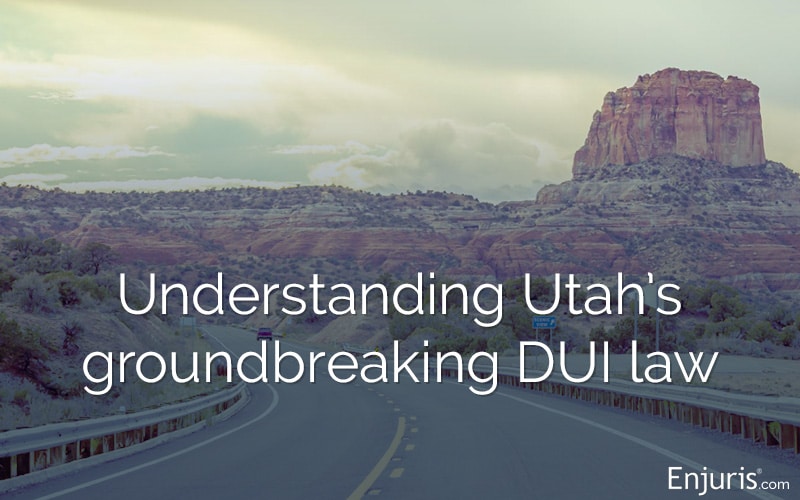
Does Utah’s 0.05 BAC limit result in fewer drunk driving accidents?
Utah takes a stringent approach to drunk driving by enforcing a 0.05% BAC limit. While the initial implementation saw a decline in alcohol-related deaths, recent years have shown an increase.
Utah became the first state in the country to lower its drunk driving threshold to a blood alcohol level of 0.05 percent.
As we take a look at the intricacies of Utah’s drunk driving laws, we’ll examine the impact of this groundbreaking decision.
Utah’s DUI laws
Utah has perhaps the strictest driving under the influence (DUI) laws in the United States. Here’s what you need to know:
- BAC limits: Utah has a BAC limit of 0.05 percent, which is lower than the 0.08 percent limit common in most other states. This means drivers can be prosecuted for DUI in Utah even if their BAC is just 0.05 percent.
- Zero tolerance for minors: Utah enforces a zero-tolerance policy for drivers under 21. This means any detectable amount of alcohol in the system of an underage driver can lead to DUI charges.
- Penalties: DUI penalties in Utah vary depending on the nature of the offense:
- First-time offenders: Penalties for initial offenses include potential jail time, substantial fines, license suspension, and mandatory DUI classes.
- Repeated offenses: Repeat offenders face increased fines and up to five years in jail.
- DUIs with aggravated circumstances: If a DUI results in severe bodily harm, fatalities, or involves minors, the charges intensify. Such circumstances can escalate the offense to felony levels with potential for years of imprisonment.
| The effects of blood alcohol concentration (BAC) | ||
|---|---|---|
| BAC | Typical effects | Predictable effects on driving |
| .02 | Some loss of judgment, relaxation, slight body warmth, altered mood | A decline in visual functions (rapid tracking of a moving target) and a decline in the ability to perform 2 tasks at the same time |
| .05 | Exaggerated movement, some loss of small-muscle control (e.g., focusing your eyes), impaired judgment, lowered alertness, the release of inhibition | Reduced coordination, reduced ability to track moving objects, difficulty steering, reduced response to emergency driving situation |
| .08 | Muscle coordination becomes poor (e.g., balance, speech, vision, reaction time, and hearing), harder to detect danger; judgment, self-control, reasoning, and memory are impaired | Concentration, short-term memory loss, speed control, reduced information processing capability (e.g., signal detection, visual search), impaired perception |
| .10 | Clear deterioration of reaction time and control, slurred speech, poor coordination, and slowed thinking | Reduced ability to maintain lane position and brake appropriately |
| .15 | Far less muscle control than normal, vomiting may occur (unless this level is reached slowly or a person has developed a tolerance for alcohol), major loss of balance | Substantial impairment in vehicle control, attention to driving task, and in necessary visual and auditory information processing |
| Source: National Highway Traffic Safety Administration | ||
Has Utah’s strict 0.05 law worked?
Utah’s landmark decision in 2017 to enforce a 0.05 percent BAC limit wasn’t arbitrary. The decision was the result of extensive research which demonstrated impairments to reaction times and cognitive functions even at low alcohol levels. Proponents of the law also noted that countries with similar BAC limits experienced a reduction in the number of alcohol-related accidents.
But has the law worked in Utah?
In the first year the law took effect, there was a sharp decline (19.8 percent) in the number of alcohol-related deaths. However, alcohol-related deaths have risen ever since.
Over the last four years, 187 people died in alcohol-related crashes, up about 20 percent from before the law was passed. What’s more, Utah set a record for DUI-related fatalities in 2022, with 62 crashes.
More than 2,000 people with an alcohol level below the old limit of 0.08 percent have been arrested since the law was passed.
Rights of victims of drunk driving accidents
If you or a loved one has been injured in a drunk driving accident in Utah, it’s important to recognize that you have certain rights:
- Right to compensation: Utah is a no-fault insurance state, which means drivers typically file insurance claims with their own insurer, regardless of who’s responsible for an accident. However, there are certain circumstances in which a driver can file a personal injury lawsuit against a drunk driver.
- Right to legal representation: Victims have the right to hire a personal injury attorney to represent their interests. Most initial consultations are free.
- Right to sue establishments: Under certain circumstances, Utah’s “dram shop” law allows victims to sue establishments like bars or restaurants that served alcohol to an already intoxicated individual who then caused an accident.
Building a strong DUI accident case in Utah
If you’ve been involved in a DUI accident, there are certain steps you can take to ensure you receive the compensation you deserve:
- Document the scene: If possible, take photos of the accident scene, vehicle damage, and any visible injuries.
- Seek immediate medical attention: Even if your injuries seem minor initially, it’s important to consult a doctor. Some injuries manifest symptoms later, and having a medical record links the accident to the injury.
- Engage witnesses: Collect contact information from any witnesses.
- Consult a lawyer: Engage a legal professional early in the process.
How to spot a drunk driver
It’s not always easy to distinguish a drunk driver from a distracted driver. Regardless, your reaction should be the same: STAY FAR AWAY.
Mothers Against Drunk Driving (MADD) has compiled some common signs of driving while under the influence to help you spot a drunk driver:
- Tailgating
- Quick acceleration
- Weaving or zig-zagging across the road
- Driving anywhere other than on a road designated for vehicles
- Almost striking an object, curb, or vehicle
- Stopping without cause or erratic braking
- Drifting in and out of traffic lanes
- Turning abruptly or illegally
- Slow response to traffic signals
- Straddling the center lane marker
- Driving with headlights off at night
- Driving into opposing traffic on the wrong side of the road
- Swerving
- Driving slower than 10 mph below the speed limit
- Signaling that is inconsistent with the driver’s actions
Drunk driving accidents can be overwhelming. The important thing is to remember that you don’t have to deal with the aftermath alone. In addition to hiring an attorney to handle the legal issues, there are resources to help with the emotional recovery following an accident.
See our guide Choosing a personal injury attorney.

